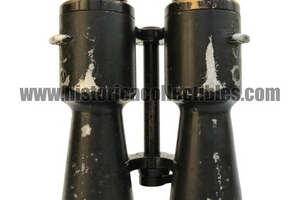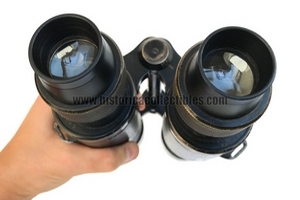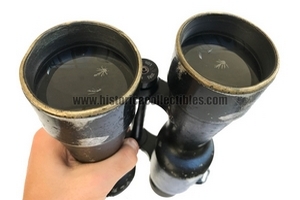Doppelfernrohr 8x56 Emil Busch A-G. (Aktiengesellschaft) Rathenow, about 1900
8x56 binoculars manufactured by Emil Busch A-G. (Aktiengesellschaft) by Rathenow, circa 1900. Unfortunately, at the moment we do not have any in-depth technical and historical information on this specific model, however by carefully observing the powerful and heavy construction of the structural body, as well as the processing of the two eyepiece groups made entirely of bronze, we can note the notable quantity of materials and technology used for its creation.
Although the binoculars weigh up to 2.2 kg, its linear and balanced design makes this pleasantly easy to handle even in prolonged use, therefore based on these findings we can state with considered reasonableness that this binoculars were part of a batch commissioned from Emil Busch A-G. Rathenow, by the Kaiserliche Marine and its production was limited to very few examples to be used exclusively by officers at the highest command ranks of the German Imperial Fleet.
Fully functional in the mechanical parts, still perfectly collimated with prisms and clear lenses that release very sharp images. There is its pressed cardboard case covered with oilcloth.
History of Emil Busch:
The origins of this company date back to 1789, when Johann Heinrich August Duncker started a small business manufacturing lenses for glasses and microscopes in the German city of Rathenow. He was born in 1767, the son of a Pastor who had initiated him into theological studies, during which the young man had also acquired considerable practical knowledge on the manufacture and processing of optical glass (turning and grinding) being very attracted by physics and mathematics .
One of the factors favoring the initiative is constituted by the ban on the importation of glasses from abroad issued since 1772 by the Prussian government: the small artisan company initially availed itself of the financing of another Pastor, Samuel Cristoph Wagener, by virtue of which it developed rapidly, so much so that in 1801 it obtained recognition as a "privileged industry" from the King of Prussia, Frederick William III.
This fact allows us to expand the activity to a proto-industrial level, also by virtue of the patent of the "Vielschleifmaschine", a piece of equipment used for crushing optical glass, the first step towards the production of lenses for glasses or microscopes. The company takes the name of Optische Industrie Anstalt and grows economically in a very short time; the success factors are linked to the quality of the product, to a widespread sales system through many specialized sales points and also to the possibility of the buyer obtaining a personalized calibration of the product purchased.
Currently these methods of distribution appear completely obvious, but at the time the sale of glasses was carried out largely with the "door to door" system by street salesmen and therefore buyers had to be satisfied with a standardized product. Duncker also employs orphaned children and war invalids in his company, guaranteeing them a livelihood and provides glasses free of charge to poor people who cannot afford to buy them; in 1919 he fell seriously ill and the management of the company was taken over by his son Eduard Dunker, who expanded production to ear tubes.
In the early 1940s the activity took on the characteristics of a real industry, specialized personnel now worked in the company and many were forced to work at home as the premises were no longer adequate for the level of production; in 1843, 250,000 lenses and 40,000 pairs of glasses were produced, of a more modern shape and concept, with a steel frame.
Distribution is also now global in size, around 300 stores spread not only in Europe, but also in New York and Moscow. Having no children, Duncker sent his nephew Emil Busch to Berlin to attend specialization courses in the optical sector with the aim of preparing for the succession: in 1845 Busch took over the reins of the company and immediately demonstrated the level of preparation he had acquired. He modified production methods by introducing steam as a driving force in the optical glass cutting sector and towards the middle of the century the technology he used was probably the most modern in the whole of Germany.
In 1852 the production of photographic equipment and especially lenses for the nascent German industry began; the volume of business that revolves around Emil Busch creates an industry of large proportions, so much so that in 1863 in Rathenow there were officially 163 small companies operating in the optical sector, a clear legacy of those workers who twenty years earlier worked at home.
Since 1864 it has been a supplier of binoculars to the armed forces (both German and European) and in 1865 it began production of the Pantoscop, a wide-angle lens designed within the company. In 1872 the factory, which in the meantime had taken the name of Optische Anstalt Rathenow, became Emil Busch AG; in 1877 Busch and Dunker (who died the following year) created a foundation consisting of a sort of pension fund for employees, to be activated in the event of a cessation of production due to economic difficulties.
In 1900 Rathenow was the center of German industry for the processing of glass intended for the production of lenses, photographic and otherwise; in the meantime the collaboration began with Carl Zeiss of Jena and with Schott und Genossenda from which the optical glass was purchased, while the business expanded enormously. In this period, two particular products were also made, the so-called Busch Vademecum and the series of optics marked "ROJA", built from 1900 to 1910.
The Busch Vademecum is made up of a set of combinable optical groups with which various focal lengths can be created and which in fact allows the photographer to have something that is very similar to a series of interchangeable lenses; the lenses are contained in a case and can be mounted on a support tube which becomes the central body of the lens as it is equipped with an iris diaphragm. The ROJA series lenses, on the other hand, are high-quality optics with a fixed focal length, intended primarily for large format cameras.
In 1927 the majority of the company's shares were purchased by Zeiss, even if Busch continued the production of its own photographic equipment. At the end of the Second World War, Emil Busch AG, accused among other things of collaboration due to military supplies to the Third Reich, was acquired by the East German government, which transformed it into several state companies including VEB Rathenower Optische Werke and VEB Augenoptik “Hermann Duncker”. After German reunification, Rathenow's optical companies continued their activity, despite a significant downsizing in staff following mergers and mergers.





